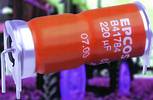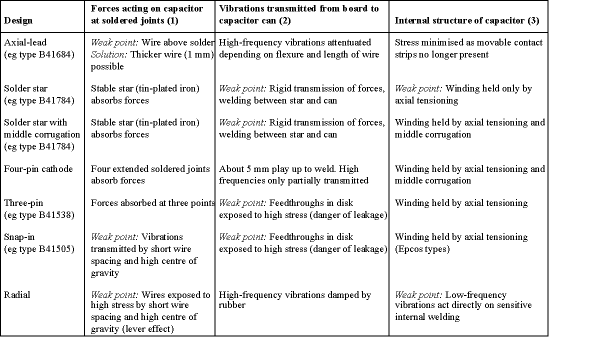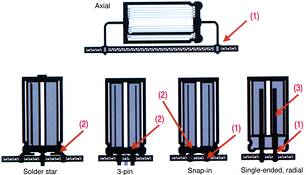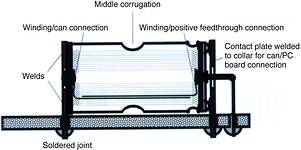
Automotive electronics calls for rugged components of extreme reliability. A key requirement for aluminium electrolytic capacitors is vibrational strength, so choosing the right design is vital to reliable operation. This article from Epcos describes the company’s new capacitor designs that ensure optimum long-term mechanical and thermal stability under the toughest conditions.
As the number of electrical loads in motor vehicles increases and control is decentralised, the energy required must be made available locally. Wherever inductive loads (stepper motors, windshield wipers, valve controllers) are operated, a sufficient energy reservoir must be provided in their immediate vicinity.
Tried and tested aluminium electrolytic capacitors from EPCOS are the only type of capacitor that combine all the properties required, such as high current-handling capability, low impedance and compact design. For example the electrolytic capacitor series B41684/B41784 for 42 V automotive power supply systems operate at the rated voltages of 25 and 40 V, and even the 63 and 100 V commonly required in motor vehicles, delivering capacitances from 330 µF to several millifarads.

Improved reliability
Aluminium electrolytic capacitors are exposed to particularly high thermal and mechanical stresses in automotive applications, but must still satisfy tough reliability demands. In cooperation with leading European motor manufacturers, Epcos has managed to increase the reliability of the B41684/B41784 series of axial-lead capacitors decisively over that of standard versions. They now have a failure probability of only 1ppm throughout the service life of the vehicle. This reliability statement is substantiated by comprehensive, documented tests covering temperature reversal, storage at high and low temperatures, pulse strength and continuous voltage.
Reliability is ensured over -55 to 125°C and even up to 150°C with reduced current or voltage loads. The service life of these series - more than 3000 hours at 125°C - is long enough to cover typical temperature profiles safely and reliably, even for future vehicle generations with specified service lives of 12 to 15 years.

Vibration and shock
Although these aluminium electrolytic capacitors satisfy the key reliability requirements of high temperature stability and extremely low failure rates, resistance to vibration and shock merit special attention from designers (Table 1). Depending on the shape of the can and contacts, various weak points may emerge which must be taken into account in system design (Figure 2). Typical problem areas are: Forces acting on the capacitor at the soldered joints (1); Transmission of vibrations from PC board to capacitor can (2); Internal structure of the capacitor (3).

Designing in stability
Depending on vibration requirements, axial or radial-lead capacitors can be used. Of the two variants, axial designs offer considerably higher operational reliability because the component is attached to the board at both ends with greater spacing and the centre of gravity is significantly lower. Axial-lead capacitors should therefore be generally preferred for applications involving strong vibrations. Vibrational strength can also be increased by selecting a thicker wire with a diameter of 1,0 mm instead of the usual 0,8 mm for larger cans with diameters from 14 mm. Additional protective measures which have proved effective in practical design include reinforcement with clamps or partial encapsulation.
Epcos is the only manufacturer to offer an aluminium electrolytic capacitor with a four-pin cathode for PCB mounting that can also withstand extremely strong vibrations. The cathode (negative pole) comprises two collars, one at either end of the can. A contact plate with two integral pins is welded to each collar. The cathode is thus electrically and mechanically connected to the circuit board via four solder pins altogether. The wire normally welded to the cathode is thus dispensed with. The positive terminal is no longer used for mechanical fastening, but for electrical contact only (Figure 3). Vibrational strength has thus been increased from 10 g in the standard version to 30 g in the four-pin cathode version. Another advantage is reduced inductance.

Where vibrational loads are less extreme, designers will attempt to avoid the expense of external fastening. If space is too limited for the horizontal design with four cathode pins, an aluminium electrolytic capacitor with solder-star connection is the optimum solution for many applications.
If the axial-lead capacitor is not fixed by special measures taken by the user or by its design (solder star, four-pin cathode), the terminal wires represent a trouble spot in terms of vibrations. However, an axial-lead capacitor with terminal wires still has the edge over other leaded components such as radial-lead capacitors because its wide-legged structure with a low centre of gravity can better withstand low-frequency vibrations and the long wires can better absorb high-frequency vibrations.
Vibrations in the capacitor
It is of course important for the capacitor can itself to withstand high vibrational stresses. Axial-lead and solder-star capacitors from Epcos designed for high-vibration applications do this in three ways:
* Standard axial tensioning of the winding between can base and cover plate to absorb axial vibrations.
* Optional corrugation in the middle, which presses against the winding and fixes it in place to absorb vibrations at right angles to the longitudinal axis.
* Mechanical structure without moving parts. The contact strips inside the capacitor in particular are fastened under the ends of the winding by axial tensioning.
The optional corrugation in the middle fixes the aluminum foil winding inside the capacitor and thus prevents the contact strips connected to the can or anode from shearing off. A single corrugation of defined shape formed after insertion of the winding is sufficient to suppress vertical vibrations. Although two-corrugation designs are also commercially available, the function of the second corrugation is to absorb axial forces, which is already in the Epcos design, is already taken care of by axial tensioning.
Welding of the wires to the can and rivet is another important design factor. These bonds must be stable enough to withstand all shocks transmitted along the wires to the can. The rivet of the axial-lead capacitor provides strain relief to protect the more sensitive contacts inside from external shocks. In aluminium electrolytic capacitors with plugs (radial and older axial-lead types) on the other hand, the forces are transmitted along the wires to the more sensitive internal contacts because the wire outside and inside the component forms a single mechanical unit. The welded contact thus has a decoupling effect and offers additional protection against vibrations.
Summary
Aluminium electrolytic capacitors of high capacitance are becoming more and more important in automotive power supply systems for energy storage and interference suppression. These applications demand extremely high mechanical and thermal stability. New capacitor designs and series developed by Epcos ensure optimum long-term stability under the toughest conditions in commercial vehicles and construction machinery.
| Tel: | +27 11 458 9000 |
| Email: | [email protected] |
| www: | www.electrocomp.co.za |
| Articles: | More information and articles about Electrocomp |

© Technews Publishing (Pty) Ltd | All Rights Reserved